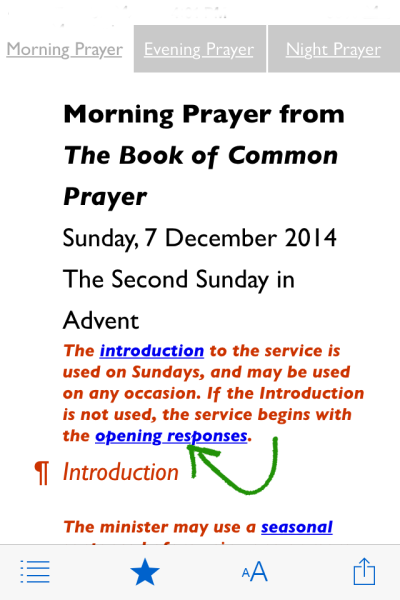 Welcome to part 3 of How to Pray! If you’re interested in the background and reasons to read and pray every day using the Daily Office, check out Part 1. If you need the schedule and resource links for when and what to pray, check out Part 2.
Welcome to part 3 of How to Pray! If you’re interested in the background and reasons to read and pray every day using the Daily Office, check out Part 1. If you need the schedule and resource links for when and what to pray, check out Part 2.
This post is the detailed elaboration on Option 1 of the ‘Simple Plan’ with Morning, Evening and Night Prayer discussed generally in a previous post here.
Some fancy words and adaptations used in the Daily Prayer App that will help you understand how to use it at home:
Minister – The text that is in black font and not bolded indicate the part of the minister. When at home, and not at a church service, the person who speaks as the minister should be the father or husband. If there is no father present, the head of household can read the part of the minister (wife with children). If you are praying alone, you may read this part along with the responses.
Collect – (Pronounced KAH-leckt) This is a short general prayer written by our great church fathers.
The Apostles’ Creed – This is an early statement of faith that should be recited every day.
Italicized Red Font – These are the instructions or titles of prayers, readings and psalms (you don’t read these out loud). The instructions are sometimes in bold. The titles are sometimes in Latin, so it’s okay if you don’t understand it or read it, but they are the original titles of prayers and psalms.
Blue Underlined Font – These are links that take you directly to alternate prayers, readings or psalms.
The Step-by-Step Instructions for Option 1:
1) At the Home menu, click on “Today” and it will take you to the prayers and readings for today divided into three sections: Morning Prayer, Evening Prayer, and Night Prayer.

2) Make sure you’re on the “Traditional” setting to get the text from the original 1662 version of the Book of Common Prayer

3) After getting back to the prayer, choose “Morning Prayer,” “Evening Prayer,” or “Night Prayer.” I will continue the demonstration with “Morning Prayer.” At the bottom of the first red paragraph, you’ll see a link to “opening responses,” click that. I don’t read the “introduction” for family prayer. It should be read for church services and occasions, but not for home family prayer. Night Prayer usually doesn’t have the “introduction” so you don’t need to skip anything.

4) Before starting, I like to stay standing with the family through the opening, psalms and readings. We transition to kneeling for the prayers. Read the Opening Responses usually starting out with “O Lord, open thou our lips.” The father or husband should read the plain text and all the family respond together. In the case that it’s just you and your husband, the husband should read just the unbolded and the wife read the bolded text.

5) Read the Venite exultemus Domino or Psalmody (Psalms) responsively by whole verse. The father/husband/head should lead and the others respond. Once again, if you are alone, just pray through the whole thing.

6) At the end of each psalm, everyone should recite the “Glory be to the Father” together (we prefer to sing it). Then, the readings should be read by the father/husband/head and each reading is followed by a response read or sung together.

7) Continue in like fashion until the scripture readings are concluded. Then, the Apostles’ Creed should be recited together.

8) At the beginning of the Prayers, wait until after “The Lord be with you And with thy spirit” to kneel. Pray responsively in like fashion to the opening responses with the father/husband/head reads the part of the minister. If you are alone, just kneel and start with “Lord, have mercy upon me.”

9) The Collects should be read by the father/husband/head alone.

10) You may want to conclude with a hymn (this is a great opportunity to get your kids involved and singing! They could prepare music for family prayers). After the collects and hymn, this is where we pray in a free-form manner, bringing forth to God personal praises and requests. We like to start with the father, then each child, then end with the mother. Then the family prayer time concludes with the last prayer spoken by the father/husband/head and everybody says “Amen.”

Tips for if you find yourself short of time:
- Pray aloud – this will keep you awake, in fact, if you like to sing, sing your prayers! You can learn more about this when I write about how to chant, but the quick explanation is just pick one note and say everything on this one note. (We use F4 for females and F3 for males)
- Pray the minimums – at least pray the Psalms, Creed and the Lord’s Prayer
- Pray shorter scripture excerpts – rather than cutting out the scriptures or skipping over the Old Testament readings (because I know you had that same thought as me), at least read one verse from each selection to allow your mind and heart be exposed to the sections of the Bible that the founders of the BCP found important
- Pray the Jesus Prayer – When alone, start your prayers with “Lord Jesus Christ, son of God, have mercy on me, a sinner,” and end with “Lord Jesus Christ, son of God, have mercy on me”

Pingback: How to Pray (Part 2): Adapting the Daily Office to Home Prayer | The Anglican Mom
Pingback: How to Pray (Part 1): Read & Pray Every Day with the Daily Office | The Anglican Mom